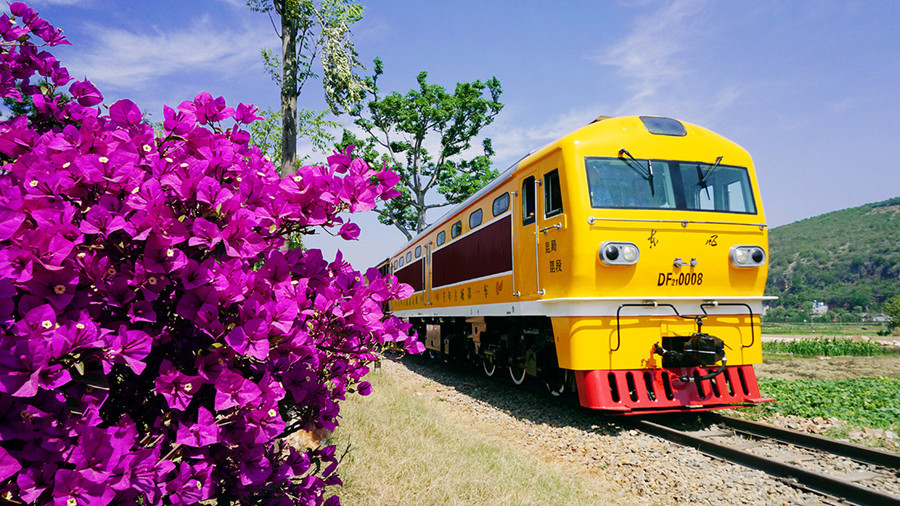
Yunnan Eighteen Oddities: Trains go abroad but not inland
Yunnan 18 Oddities: Automobiles move faster than trains
Yunnan 18 Oddities: Trains go abroad but not inland
One of the most commonly cited “Eighteen Oddities of Yunnan” is that “automobiles move faster than trains” (火车没有汽车快). This oddity stems from the unique historical and geographical factors affecting the railways in Yunnan.
Historical Background: The Yunnan-Vietnam Railway
The saying that “trains move slower than automobiles” largely originates from the Yunnan-Vietnam Railway (滇越铁路). This railway was constructed from 1901 to 1910, spanning 854 kilometers from Kunming to Haiphong, with 465 kilometers in Yunnan and 389 kilometers in Vietnam. The railway, funded by the French, was a significant engineering feat, costing approximately 158,466,888 French francs and involving over 64,000 workers.

Despite its historical importance as the first international railway in China, the Yunnan-Vietnam Railway is characterized by its narrow gauge (one meter) and the challenging terrain it traverses. This resulted in a slower train speed, making automobiles on the newly constructed roads faster by comparison.
Engineering Challenges
Yunnan’s rugged terrain, with an average elevation of over 2,000 meters, poses significant challenges for railway construction. The Yunnan-Vietnam Railway, for instance, navigates steep gradients and sharp curves, making speed control crucial for safety. Additionally, the railway’s construction includes numerous tunnels (150) and bridges (173), with the renowned “Human-shaped Bridge” at Hekou being a notable example of engineering prowess.

Comparisons with Automobiles
With the advent of roads and the introduction of automobiles in the early 20th century, the speed advantage of cars became apparent. Automobiles could navigate the region’s challenging topography more flexibly and at higher speeds compared to the narrow gauge trains. For instance, while a train journey from Kunming to Kaiyuan might take around 8 hours, the same trip by car could take approximately 5 hours.
Modern Railway Developments
While the older narrow gauge trains were slow, newer standard gauge railways like the Guikun Railway (贵昆线) and Chengkun Railway (成昆线) also face significant speed limitations due to the difficult terrain. The Chengkun Railway, for example, is famous for its extensive use of tunnels and bridges, with 48 kilometers of the 66-kilometer stretch between Ebian and Wushenghe stations consisting of tunnels.

The Future of Yunnan’s Railways
Despite these challenges, there are efforts to modernize and improve railway speeds in Yunnan. For instance, there are plans to repurpose parts of the historical railways for tourism, enhancing their cultural and historical value. The establishment of a railway museum in Kaiyuan aims to educate visitors about the historical significance and technological evolution of rail transport in Yunnan.
Yunnan 18 Oddities: Trains Go Abroad but Not Inland
Another related oddity is that “trains go abroad but not inland” (火车不通国内通国外), highlighting the historical peculiarity of Yunnan’s railway connections.

The Yunnan-Vietnam Railway’s Historical Significance
As the first international railway in China, the Yunnan-Vietnam Railway facilitated trade and cultural exchange between Yunnan and Southeast Asia. While this international connection was significant, it also meant that for many years, Yunnan had better railway links to Vietnam than to other parts of China.
Limited Domestic Railway Network
Historically, Yunnan’s domestic railway network was limited. The challenging terrain and the high costs associated with railway construction in the region meant that extensive domestic railway connections developed more slowly. This left Yunnan relatively isolated from the rest of China’s railway network for much of the early 20th century.
Modern Developments
In recent decades, significant efforts have been made to expand Yunnan’s domestic railway network. Modern standard gauge railways like the Guikun and Chengkun lines have improved connectivity, but the historical legacy of limited domestic connections compared to international ones remains a notable aspect of Yunnan’s railway history.
Conclusion
The oddities that “automobiles move faster than trains” and “trains go abroad but not inland” reflect the unique historical, geographical, and cultural context of Yunnan. These peculiarities highlight the challenges and achievements in developing transportation infrastructure in this mountainous and diverse region. Despite these challenges, Yunnan continues to evolve, integrating its rich historical legacy with modern advancements in transportation.

 7 Days GolfingTour
7 Days GolfingTour
 8 Days Group Tour
8 Days Group Tour
 8 Days Yunnan Tour
8 Days Yunnan Tour
 7 Days Shangri La Hiking
7 Days Shangri La Hiking
 11 Days Yunnan Tour
11 Days Yunnan Tour
 6 Days Yuanyang Terraces
6 Days Yuanyang Terraces
 11 Days Yunnan Tour
11 Days Yunnan Tour
 8 Days South Yunnan
8 Days South Yunnan
 7 Days Tea Tour
7 Days Tea Tour
 8 Days Muslim Tour
8 Days Muslim Tour
 12 Days Self-Driving
12 Days Self-Driving
 4 Days Haba Climbing
4 Days Haba Climbing
 Tiger Leaping Gorge
Tiger Leaping Gorge
 Stone Forest
Stone Forest
 Yunnan-Tibet
Yunnan-Tibet
 Hani Rice Terraces
Hani Rice Terraces
 Kunming
Kunming
 Lijiang
Lijiang
 Shangri-la
Shangri-la
 Dali
Dali
 XishuangBanna
XishuangBanna
 Honghe
Honghe
 Kunming
Kunming
 Lijiang
Lijiang
 Shangri-la
Shangri-la
 Yuanyang Rice Terraces
Yuanyang Rice Terraces
 Nujiang
Nujiang
 XishuangBanna
XishuangBanna
 Spring City Golf
Spring City Golf
 Snow Mountain Golf
Snow Mountain Golf
 Stone Mountain Golf
Stone Mountain Golf










